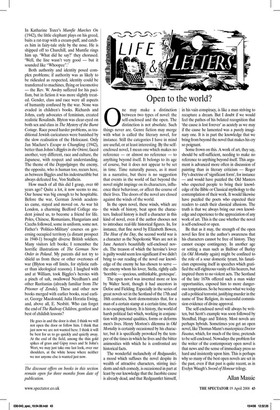Open to the world?
One may make a distinction between two types of novel: the self-enclosed and the open. The distinction is not absolute. Such things never are. Genre fiction may merge with what is called the literary novel, for instance. Still the categories I have in mind are useful, or at least interesting. By the selfenclosed novel, I mean one which makes no reference — or almost no reference — to anything beyond itself. It belongs to its age of course, but it does not appear to be set in time. Time naturally passes, as it must in a narrative, but there is no suggestion that events in the world of fact beyond the novel might impinge on its characters, influence their behaviour, or affect the course of their lives. The doors of the novel are closed against the winds of the world.
In the open novel, these winds, which are the winds of history, beat upon the characters. Indeed history is itself a character in this kind of novel, even if the author chooses not to introduce real-life historical figures. In, for instance, that fine novel by Elizabeth Bowen, The Heat of the Day, the second world war is a character as the Napoleonic Wars are not in Jane Austen’s beautifully self-enclosed novels. The treason of which the heroine’s lover is guilty would seem less significant if we didn’t bring to our reading of the novel our knowledge of the enemy he has chosen to serve — the enemy whom his lover, Stella, rightly calls ‘horrible — specious, unthinkable, grotesque’.
The open novel was invented more or less by Walter Scott, though it had ancestors in Defoe and Fielding. Especially in the series of great novels set in the Scotland of the 17th and 18th centuries, Scott demonstrates that, for a man of a certain stamp at a certain time, there is no escaping history. It is history, the world of harsh political fact which, working in conjunction with personal qualities, forms or deforms men’s lives. Henry Morton’s dilemma in Old Mortality is certainly occasioned by his character, but it is specifically provoked by the temper of the times in which he lives and the bitter animosities with which he is confronted are historical facts.
The wonderful melancholy of Redgauntlet, a mood which suffuses the novel despite its wealth of attractive characters, stirring incidents and rich comedy, is occasioned in part at least by our knowledge that the Jacobite cause is already dead, and that Redgauntlet himself, in his vain conspiracy, is like a man striving to recapture a dream. But I doubt if we would feel the pathos of his belated recognition that ‘the cause is lost forever’ as acutely as we may if the cause he lamented was a purely imaginary one. It is in part the knowledge that we bring from beyond the novel that makes his cry so poignant.
Some frown on this. A work of art, they say, should be self-sufficient, needing to make no reference to anything beyond itself. This argument is advanced more often in discussion of painting than in literary criticism — Roger Fry’s doctrine of ‘significant form’, for instance — and would have puzzled the Old Masters who expected people to bring their knowledge of the Bible or Classical mythology to the contemplation of their work. It would likewise have puzzled the poets who expected their readers to catch their classical allusions. The truth is that we always bring our own knowledge and experience to the appreciation of any work of art. This is the case whether the novel is self-enclosed or open.
Be that as it may, the strength of the open novel lies first in the author’s awareness that his characters cannot be free of history. They cannot escape contingency. In another age or setting a man such as Balfour of Burley (in Old Mortality again) might be confined to the role of a sour domestic tyrant, his fanaticism expressing itself in speeches which gratified the self-righteous vanity of his hearers, but inspired them to no violent acts. The Scotland of the late 1670s offered such a man wider opportunities, exposed him to more dangerous temptations. So he becomes what we today call a political terrorist, justifying murder in the name of True Religion, its successful commission evidence of divine approval.
The self-enclosed novel will always be written, but Scott’s example was soon followed by Stendhal, Hugo and Tolstoy. Most novels are perhaps hybrids. Sometimes you get an open novel, like Thomas Mann’s masterpiece Doctor Faustus, which, for much of the time, pretends to be self-enclosed. Nowadays the problem for the writer of the contemporary open novel is that news and the sense of immediacy press so hard and insistently upon him. This is perhaps why so many of the best open novels are set in the past, even if that past is quite recent, as in Evelyn Waugh’s Sword of Honour trilogy.
Allan Massie


















































































 Previous page
Previous page